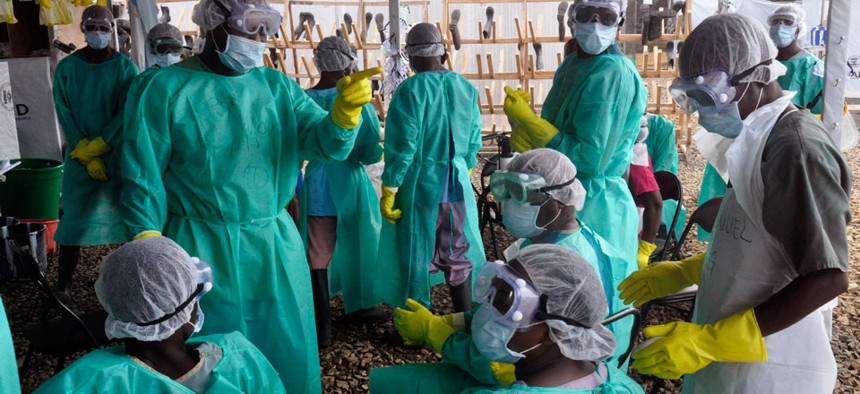The Limits of Technology in Fighting Ebola

Health care workers inside a USAID, funded Ebola clinic with their Ebola virus protective gear in Monrovia, Liberia. Abbas Dulleh/AP
As the outbreak continues, USAID and other agencies are still investing and prototyping new devices, often looking to the private sector and the general public for ideas.
A year after the recent Ebola outbreak was first reported, the federal government is assessing how experimental technology -- wrist-worn devices that automatically monitor patients’ vital signs, for instance -- could help contain it or a future health crisis.
As the outbreak continues in parts of Western Africa, the U.S. Agency for International Development and other agencies are still investing and prototyping new devices, often looking to the private sector and the general public for ideas. Federally-funded research projects include wearable monitors and new personal protection equipment suits, among others.
At a Thursday event hosted by USAID and the White House Office of Science and Technology and Policy, agency representatives discussed how collaboration and crowdsourcing could advance health-related technology.
But gaps still remain, the innovators concede.
"We need to achieve real-time biosurveillance capability,” National Security Council Senior Director Amy Pope said at the event. “We just don’t have it.”
The conversation took place just weeks after USAID Chief Innovation Officer Steve VanRoekel, the former federal chief information officer, stepped down from his post.
Last year, USAID, along with the Defense Department and the Centers for Disease Control and Prevention, kicked off the Ebola Grand Challenge, providing investment opportunities to technologists with creative and potentially viable inventions.
So far, the agency has funded about 15 of these projects, out of about 1,000 submissions, said Wendy Taylor, the director of USAID’s Center for Accelerating Innovation and Impact.
Among ideas that have won USAID funding is a PPE suit with a simpler removal process -- with a zipper in the back and tabs on the sleeves -- designed to minimize health care workers’ exposure to contaminants such as vomit.
Researchers from Johns Hopkins University are developing the suit; its breathing mask is arranged so patients can see more of the health care workers’ faces, and it includes a cooling system pumping dry air into the suit. (DOD is currently working on a test-plan for these and other suit prototypes to ensure they can withstand potential contamination.)
USAID is also backing a wrist-worn vital signs monitoring system, developed by the Scripps Translational Science Institute. In conjunction with a predictive analytics platform developed by PhysIQ, the system could eventually predict health events so they could be addressed sooner. Another lower-cost vital signs monitor prototype, called the MultiSense Memory Patch, is a Band-Aid-shaped adhesive sensor, mounted on the patient’s sternum.
“The idea of having that constant monitoring of all patient vitals remotely -- having an ability to relieve the health care workers so they can focus on other parts of care can really be quite powerful," Taylor said.
The Resilient Africa Network (a collective of various global universities, funded by USAID) is designing a well-ventilated and modular tent, meant to create makeshift hospitals.
During the event, USAID’s innovation specialist Eric King noted that improvements in data collection are also integral to containing the outbreak. For instance, nonprofit eHealth Africa operates hotlines in affected parts of West Africa to gather information on reported or potential cases, he said.
Chris Weasler, Facebook’s director of global connectivity, noted that his company along with Cisco and nonprofit consortium NetHope were setting up broadband Internet access in Ebola treatment facilities, so responders could actually access and use the new technologies being prototyped.
He added that Facebook has also been pushing educational material about Ebola and emergency numbers, where users could report dead bodies, in affected parts of the world.
But a handful of representatives from health organizations noted that while advanced technology might be useful in theory, some of the new concepts are only feasible with a reliable Internet connection and working electricity, and aren’t always viable in the field.
“These innovations are very needed,” said virologist Joseph Fair, an adviser at Fondation Merieux, a nonprofit dedicated to fighting infections disease. But he added, “during an outbreak is not the time to roll them out.”





